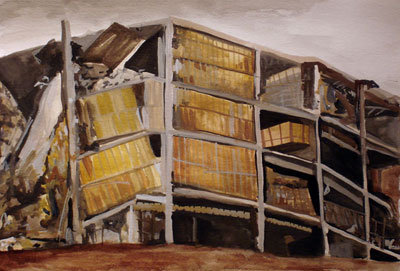The Atrocity Exhibition
dal 27/6/2007 al 27/8/2007
Segnalato da
27/6/2007
The Atrocity Exhibition
Thierry Goldberg Projects, New York
A group show featuring oevres by Ahmed Alsoudani, Ben Grasso, Wendy Heldmann, and Molly Larkey. The selected work represents destruction and disaster while moving from moments of suspended explosion to its aftermath.

Ahmed Alsoudani + Ben Grasso + Wendy Heldmann + Molly Larkey
A group show featuring work by Ahmed Alsoudani, Ben Grasso, Wendy Heldmann, and Molly Larkey. The selected work represents destruction and disaster while moving from moments of suspended explosion to its aftermath. THE ATROCITY EXHIBITION borrows its name from the J.G. Ballard novel of the late sixties.
"This is the way, step inside . . . Take my hand and I'll show you what was and will be." --Joy Division, "Atrocity Exhibition," Closer, 1980.
Ben Grasso's drawings present explosions at the moment of their becoming, not before or after. In this sense, he avoids any sentimental reaction--a world torn apart without comment. The appeal and fixation of such images confronts the viewer with the destructive nature within. As J.G. Ballard has said, "It's a mistake to hold back and refuse to accept one's own nature," and Grasso's work holds this in regard. As isolated explosions, it is impossible to discern any context whatsoever in the drawings. Without any hint of cause, one is unable to figure if this was a direct hit or an arsenal exploding on itself.
Explosion reaches its most formal point in Molly Larkey's Bomb series. This formalization sites a distance from the actual catastrophe of the atomic bomb. Her sculptures bring to mind Isa Genzken's play between the object and its pedestal as she nods to the constructions of Franz West. The visual weight of the mushroom clouds sculpted in Hydrocal serves to monumentalize the explosion. The atom bomb is an object of contested negotiation, and Larkey's commodification of it takes on that value.
Ahmed Alsoudani's work, whether or not dealing directly with the war in his native Iraq, conveys empathy for human suffering. Depicting ambiguous scenes of violence, he scatters weapon and body parts across the picture plane. These compositions of mixed parts capture sudden confusion in unique balance between pure form and reality. Alsoudani employs that vocabulary to convey present day wartime horrors while alluding to the early works of Gorky or de Kooning at their transition period from figure to form.
In the back room, Wendy Heldmann presents the aftermath. Through a suite of small-scale paintings, she explores the intricacy and delicacy of defeated structures. These buildings have either fallen victim to the violence of war or to nature. The series documents architectural remains in a timeless sense without any indication of when, what decade, the disaster occurred as all style is obliterated. Emotion too disappears as Heldmann extrapolates reactions to such disasters for banal titles such as What can we say and None of the senses can come to it. Heldmann's work lingers over the wreckage flirting with disaster.
Ahmed Alsoudani lives and works in New Haven, Connecticut. He holds a BFA in painting from the Maine College of Art, Portland, Maine, and is currently working on his Master's degree in painting at Yale University, New Haven, Connecticut. His work has been exhibited at The Museum of Contemporary Art, Portland, Maine; The Gwangju Museum of Art, Gwangju, South Korea; and at Filament Gallery, Portland, Maine.
Ben Grasso lives and works in New York. He received an MFA in Painting from Hunter College, New York; a BFA in Painting from The Cleveland Institute of Art, Cleveland, Ohio; and has studied at the Edinburgh College of Art, Edinburgh, Scotland. Grasso's work has been exhibited at Sixtyseven Gallery in New York (solo); Agenzia 04, Bologna, Italy; White Columns, New York; Momenta Art, Brooklyn, NY; and at Bucket Rider Gallery in Chicago, IL.
Wendy Heldmann lives and works in Los Angeles, California. She holds an MA from Goldsmith's College, London, England, and a BFA from The San Francisco Art Institute, San Francisco, California. Her work has been exhibited at sixspace (solo), 4F Gallery (solo), Cirrus Gallery, and New Chinatown Barbershop in Los Angeles; The Torrance Art Museum, Torrance, CA; and at Kenise Barnes Fine Art, Larchmont, NY.
Molly Larkey lives and works in New York. She holds an MFA from Rutgers University, New Brunswick, NJ and a BA from Columbia University, New York. Her work has been exhibited at PS122 (solo), Artists' Space, The Drawing Center, Roebling Hall (Satellite), Esso Gallery, Marvelli Gallery, and Jack the Pelican Presents in New York, and at Samson Projects, Boston, MA. Her most recent work is currently on view in a project room at P.S.1., LIC, NY.
Image: Wendy Heldmann, We fall asleep with one hand under our head, 2007, acrylic on paper, 12" × 18"
Thierry Goldberg Projects
5 Rivington Street 212 - New York



